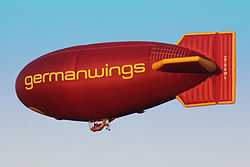Thermal airship

A thermal airship is an airship that generates its lift via the difference in density due to a temperature differential between the gas inside its envelope and the ambient air. (This is in contrast to using a gas that is lighter than air at ambient temperature, such as helium.) Currently all thermal airships use hot air, as used in a hot air balloon, as their lifting gas. However, an airship that uses steam would also qualify as a thermal airship.[1]
Advantages and disadvantages
Thermal airships have the advantage of being much less expensive than helium-based airships. They are also routinely deflated after each flight and can be readily packed for storage and/or transport.
Hot air craft produce much less uplift per unit volume than helium- or hydrogen-filled craft (about 30% depending on air conditions). This necessitates lighter construction, with fewer controls and hence more difficulty in manoeuvring. This leads to:
- lower airspeeds
- difficulty in handling on the ground if the ground wind is above 5 knots
- difficulty in steering, particularly at low airspeeds
- lack of elevator (pitch) control, causing the airship to pitch up or down in response to changes in the throttle setting (a motion called 'porpoising').
In recent years, the steering of these ships has improved somewhat. The most successful approach has been to use higher pressure in the tail fin structures than in the rest of the envelope, or to use an internal structure (see below).
History

The first public flight of a hot air airship was made by Don Cameron (UK) in a Cameron D-96 at the Icicle Meet in January 1973. The aircraft reportedly took 3 years to develop.
Envelope structures
Most thermal airships are non-rigid. Some are pressurized. In some cases, the pressurized air is taken from a duct located behind the propeller. In other cases, the pressurized air comes from a separate fan.
In 2006, a new type of envelope employing a tensile membrane structure was developed by Skyacht Aircraft. This design uses an unpressurized envelope and an internal structure that uses ribs made of aluminium to keep the envelope in shape. When not in use, the structure folds up in a manner similar to an umbrella. The structure also permits the mounting of a steerable engine/propeller on the tail of the aircraft. The tail-mounted propeller provides for vectored thrust steering, allowing tight turns.[2]
Operation
Like hot air balloons, thermal airships are first inflated partially with cold (ambient temperature) air. Once the envelopes are sufficiently full, a propane burner is ignited and the inflation is completed using heated air.
See also
References
External links
- Hotair-Airship-Blog
- Hot air airship site
- The Flying Kettle Steam Balloon Project
- Gefa-Flug Hot Air Airships—commercial aircraft company
- Gefa-Flug Airship-Programme
- Gefa-Flug manufactured airships
- Gefa-Flug airship in action - Youtube video
- Cameron Hot Air Airships—commercial aircraft company
- Lindstrand Hot Air Airships—commercial aircraft company
- Skyacht Personal Blimp—company developing a hot air airship
- World Championship 1998—Sixth World Airship Championships held in Gatineau, Quebec on the 3rd of September, 1998.
- World Championship 2008—Eighth World Airship Championship held in Tsarskoye Selo, Russia, June 2008.
- The tree top raftRadeau des cimes
- Aerostatic tools Dany Cleyet-marrel
- ART-Airships